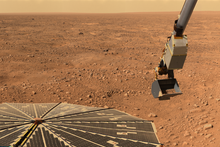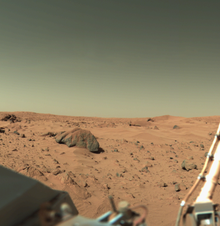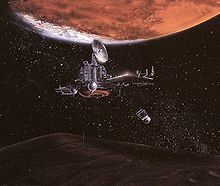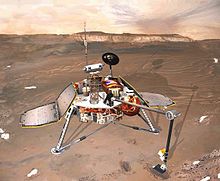- Mars landing
-
 View from the NASA Phoenix lander in 2008
View from the NASA Phoenix lander in 2008
A Mars landing is a landing of a spacecraft on the surface of Mars. Of multiple attempted Mars landings by robotic, unmanned spacecraft, six were successful. There have also been studies for a possible manned mission to Mars, including a landing, but none have been attempted.
Contents
Map

Unmanned landings
Mars probe program
Main article: Mars probe programIn 1969, the Soviet Union prepared a 5-ton orbiter called M-69. Two copies of the probe, Mars 1969A and Mars 1969B, were lost in launch related complications caused by problems with the newly developed Proton rockets.[1]
In 1971, shortly after the Cosmos 419 (Mars 1971C), that intended to be a first Martian orbiter, was lost in the fourth stage of the launch due to issues concerning the failure in the separation of Cosmos' payload from the launch vehicle,[2] the Soviet Union successfully sent probes Mars 2 and Mars 3, as part of the Mars probe program M-71. The Mars 2 and 3 probes each carried a lander, both of which failed upon landing. They were the first human artifacts to touch down on Mars. Mars 2 lander impacted on Mars only while Mars 3 was the first Martian lander and was able to transmit from Martian surface during 20 second the first data and a portion of the first picture. These spaceprobes also contained the first Mars mini-rovers, although they were broken on landing.
The Mars 2 and 3 orbiters sent back a large volume of data covering the period from December 1971 to March 1972, although transmissions continued through to August. By 22 August 1972, after sending back data and a total of 60 pictures, Mars 2 and 3 concluded their missions. The images and data enabled creation of surface relief maps, and gave information on the Martian gravity and magnetosphere.[3]
In 1973, the Soviet Union sent four more probes to Mars: the Mars 4 and Mars 5 orbiters and the Mars 6 and Mars 7 fly-by/lander combinations. All missions except Mars 7 sent back data, with Mars 5 being most successful. Mars 5 transmitted 60 images before a loss of pressurization in the transmitter housing, ended the mission. Mars 6 lander transmitted data during descent, but failed upon impact. Mars 4 flew by the planet at a range of 2200 km returning one swath of pictures and radio occultation data, which constituted the first detection of the nightside ionosphere on Mars.[4] Mars 7 probe separated prematurely from the carrying vehicle due to a problem in the operation of one of the onboard systems (altitude control or retro-rockets) and missed the planet by 1300 km.
Years earlier, in 1970 Soviet Union began the design of Mars 4NM and Mars 5NM missions with superheavy unmanned Martian spacecrafts. First was Marsokhod with planned date of start in 1973 and second was Mars sample return mission planned to 1975. Both spacecrafts intended to launch on N1 superrocket. But this rocket never flew successfully and Mars 4NM and Mars 5NM projects were cancelled.[5]
Viking program
Main article: Viking programIn 1976 the two American Viking probes entered orbit about Mars and each released a lander module that made a successful soft landing on the planet's surface. The two missions returned the first color pictures and extensive scientific information. Measured temperatures at the landing sites ranged from 150 to 250 K, with a variation over a given day of 35 to 50 K. Seasonal dust storms, pressure changes, and movement of atmospheric gases between the polar caps were observed. A biology experiment produced possible evidence of life, but it was not corroborated by other on-board experiments.
While searching for a suitable landing spot for Viking 2's lander, the Viking 1 orbiter photographed the landform that constitutes the so-called "Face on Mars" on July 25, 1976.
The Viking program was a descendant of the cancelled Voyager program, whose name was later reused for a pair of outer solar system probes.
Phobos program
Main article: Phobos programTwo Soviet probes were sent to Mars in 1988 as part of the Phobos program. Phobos 1 operated nominally until an expected communications session on 2 September 1988 failed to occur. The problem was traced to a software error, which deactivated attitude thrusters causing the spacecrafts' solar arrays to no longer point at the Sun, depleting Phobos 1 batteries. Phobos 2 operated nominally throughout its cruise and Mars orbital insertion phases on January 29, 1989, gathering data on the Sun, interplanetary medium, Mars, and Phobos. Shortly before the final phase of the mission, during which the spacecraft was to approach within 50 m of Phobos' surface and release two landers, one a mobile 'hopper', the other a stationary platform, contact with Phobos 2 was lost. The mission ended when the spacecraft signal failed to be successfully reacquired on March 27, 1989. The cause of the failure was determined to be a malfunction of the on-board computer.
Mars Global Surveyor
Main article: Mars Global SurveyorAfter the 1992 failure of NASA's Mars Observer orbiter, NASA retooled and launched Mars Global Surveyor (MGS). This mission was the first successful United States mission, and the first fully successful mission overall, to the red planet in two decades when it launched November 7, 1996, and entered orbit on September 12, 1997. After a year and a half trimming its orbit from a looping ellipse to a circular track around the planet, the spacecraft began its primary mapping mission in March 1999. It has observed the planet from a low-altitude, nearly polar orbit over the course of one complete Martian year, the equivalent of nearly two Earth years. Mars Global Surveyor completed its primary mission on January 31, 2001, and completed several extended mission phases.
The mission has studied the entire Martian surface, atmosphere, and interior, and has returned more data about the red planet than all other Mars missions combined. These valuable data are archived and available publicly.[6]
Among key scientific findings so far, Global Surveyor has taken pictures of gullies and debris flow features that suggest there may be current sources of liquid water, similar to an aquifer, at or near the surface of the planet. Similar channels on Earth are formed by flowing water, but on Mars the temperature is normally too cold and the atmosphere too thin to sustain liquid water. Nevertheless, many scientists hypothesize that liquid groundwater can sometimes surface on Mars, erode gullies and channels, and pool at the bottom before freezing and evaporating.
Magnetometer readings show that the planet's magnetic field is not globally generated in the planet's core, but is localized in particular areas of the crust. New temperature data and closeup images of the Martian moon Phobos show its surface is composed of powdery material at least 1 metre (3 feet) thick, caused by millions of years of meteoroid impacts. Data from the spacecraft's laser altimeter have given scientists their first 3-D views of Mars' north polar ice cap.
On November 5, 2006 MGS lost contact with Earth and hasn't been heard from since.[7]
Mars Pathfinder
Main article: Mars PathfinderThe Mars Pathfinder spacecraft, launched one month after Global Surveyor, landed on July 4, 1997. Its landing site was an ancient flood plain in Mars' northern hemisphere called Ares Vallis, which is among the rockiest parts of Mars. It carried a tiny remote-controlled rover called Sojourner, which traveled a few meters around the landing site, exploring the conditions and sampling rocks around it. Newspapers around the world carried images of the lander dispatching the rover to explore the surface of Mars in a way never achieved before.
Until the final data transmission on September 27, 1997, Mars Pathfinder returned 16,500 images from the lander and 550 images from the rover, as well as more than 15 chemical analyses of rocks and soil and extensive data on winds and other weather factors. Findings from the investigations carried out by scientific instruments on both the lander and the rover suggest that Mars was at one time in its past warm and wet, with water existing in its liquid state and a thicker atmosphere. The mission website was the most heavily-trafficked up to that time.
Spate of failures
Main article: Mars 96Main article: Nozomi (probe)Main article: Mars Climate OrbiterMain article: Mars Polar LanderMars 96, an orbiter launched on November 16, 1996 by Russia failed, when the planned second burn of the Block D-2 fourth stage did not occur.
Following the success of Global Surveyor and Pathfinder, another spate of failures occurred in 1998 and 1999, with the Japanese Nozomi orbiter and NASA's Mars Climate Orbiter, Mars Polar Lander, and Deep Space 2 penetrators all suffering various fatal errors. Mars Climate Orbiter is infamous for Lockheed Martin engineers mixing up the usage of English units with metric units, causing the orbiter to burn up while entering Mars' atmosphere.
Mars Odyssey
Main article: Mars OdysseyIn 2001 the run of bad luck ended when NASA's Mars Odyssey orbiter arrived. Its mission is to use spectrometers and imagers to hunt for evidence of past or present water and volcanic activity on Mars. In 2002, it was announced that the probe's gamma ray spectrometer and neutron spectrometer had detected large amounts of hydrogen, indicating that there are vast deposits of water ice in the upper three meters of Mars' soil within 60° latitude of the south pole.
Mars Express and Beagle 2
Main articles: Mars Express and Beagle 2On June 2, 2003, the European Space Agency's Mars Express set off from Baikonur Cosmodrome to Mars. The Mars Express craft consists of the Mars Express Orbiter and the lander Beagle 2. Although the landing probe was not designed to move, it carried a digging device and the smallest mass spectrometer created to date, as well as a range of other devices, on a robotic arm in order to accurately analyse soil beneath the dusty surface.
The orbiter entered Mars orbit on December 25, 2003, and Beagle 2 entered Mars' atmosphere the same day. However, attempts to contact the lander failed. Communications attempts continued throughout January, but Beagle 2 was declared lost in mid-February, and a joint inquiry was launched by the UK and ESA. Nevertheless, Mars Express Orbiter confirmed the presence of water ice and carbon dioxide ice at the planet's south pole. NASA had previously confirmed their presence at the north pole of Mars.
Mars Exploration Rovers
Main article: Mars Exploration RoversShortly after the launch of Mars Express, NASA sent a pair of twin rovers toward the planet as part of the Mars Exploration Rover Mission. On 10 June 2003, NASA's MER-A (Spirit) Mars Exploration Rover was launched. It successfully landed in Gusev Crater (believed once to have been a crater lake) on 3 January 2004. It examined rock and soil for evidence of the area's history of water. On July 7, 2003, a second rover, MER-B (Opportunity) was launched. It landed on 24 January 2004 in Meridiani Planum (where there are large deposits of hematite, indicating the presence of past water) to carry out similar geological work.
Despite a temporary loss of communication with the Spirit Rover (caused by too many files being stored in its flash memory[1]) delaying exploration for several days, both rovers eventually began exploring their landing sites. The rover Opportunity landed in a particularly interesting spot, a crater with bedrock outcroppings. In fast succession mission team members announced on 2 March that data returned from the rover showed that these rocks were once "drenched in water", and on 23 March that it was concluded that they were laid down underwater in a salty sea. This represented the first strong direct evidence for liquid water being on Mars at some time in the past.
Towards the end of July 2005, it was reported by the Sunday Times that the rovers may have carried the bacteria Bacillus safensis to Mars. According to one NASA microbiologist, this bacteria could survive both the trip and conditions on Mars. A book containing this claim, Out of Eden by Alan Burdick, is due to be published in the United Kingdom. Despite efforts to sterilise both landers, neither could be assured to be completely sterile.[8]
Having only been designed for three month missions, they both lasted much longer than planned, and Spirit lost contact with Earth in March 2010. Opportunity, however, continues to carry out surveys of the planet, and surpassed 50 miles on its odometer earlier this year. These rovers have discovered new things, including Heat Shield Rock, the first meteorite to be discovered on another planet.
Mars Reconnaissance Orbiter
Main article: Mars Reconnaissance OrbiterMars Reconnaissance Orbiter is a multipurpose spacecraft designed to conduct reconnaissance and exploration of Mars from orbit. The $720 million USD spacecraft was built by Lockheed Martin under the supervision of the Jet Propulsion Laboratory, launched August 12, 2005, and attained Martian orbit on March 10, 2006.
The MRO contains a host of scientific instruments such as the HiRISE camera, CRISM, and SHARAD. The HiRISE camera is used to analyze Martian landforms, whereas CRISM and SHARAD can detect water, ice, and minerals on and below the surface. Additionally, MRO is paving the way for upcoming generations of spacecraft through daily monitoring of Martian weather and surface conditions, searching for future landing sites, and testing a new telecommunications system that will enable the orbiter to send and receive information at an unprecedented bitrate. Data transfer to and from the spacecraft will occur faster than all previous interplanetary missions combined and allowing it to serve as an important relay satellite for future missions.
Rosetta and Dawn
Main article: Rosetta (spacecraft)Main article: Dawn MissionThe ESA Rosetta space probe mission to the comet 67P/Churyumov-Gerasimenko flew within 250 km of Mars on February 25, 2007 in a gravitational slingshot designed to slow and redirect the spacecraft.[9] The NASA Dawn spacecraft also used the gravity of Mars to change direction and velocity, and did a little science in conjunction with the many probes already there. Dawn passed the red planet in February 2009.
Phoenix Lander
Main article: Phoenix (spacecraft) Camera on Mars orbiter snaps Phoenix suspended from its parachute during descent through Mars' atmosphere.
Camera on Mars orbiter snaps Phoenix suspended from its parachute during descent through Mars' atmosphere.
Being the latest mission to Mars, Phoenix launched on August 4, 2007, and touched down on the northern polar region of Mars on May 25, 2008. It is famous for having been successfully photographed while landing, since this was the first time one spacecraft captured the landing of another spacecraft onto a planetary body[10] (the Moon not being a planet, but a satellite).
Future Missions
Phoenix is to be followed by the Mars Science Laboratory, a rover more capable than Spirit and Opportunity. Originally the Mars Science Laboratory was intended for a launch during 2009 however, the launch was delayed and is presently scheduled for between November 25 and December 18, 2011.[11] A second Scout mission, MAVEN has been selected for 2013. In the far future there's the proposed Mars Sample Return Mission, but this has been delayed until at least 2016, and more probably to 2024. This mission, a collaboration between ESA and NASA, is part of the Aurora Programme.
Russia plans to launch Phobos-Grunt, a sample return mission to Phobos, along with the joint Chinese Yinghuo-1 Mars orbiter in late 2011 or early 2012.
The ESA ExoMars mission is tentatively planned for 2018. ExoMars should obtain soil samples from up to 2 meters depth and make an extensive search for organic and biochemical substances.
See also
- Mars rover
- Exploration of Mars
- Manned mission to Mars
- Colonization of Mars
- Space weather
- Google Mars
References
- ^ "NASA A Chronology of Mars Exploration". http://nssdc.gsfc.nasa.gov/planetary/chronology_mars.html. Retrieved 2007-03-28.
- ^ "NASA (NSSDC) Master Catalog Display Cosmos 419". http://nssdc.gsfc.nasa.gov/database/MasterCatalog?sc=1971-042A. Retrieved 2007-03-28.
- ^ "NASA (NSSDC) Master Catalog Display Mars 3". http://nssdc.gsfc.nasa.gov/database/MasterCatalog?sc=1971-049A. Retrieved 2007-03-28.
- ^ "NASA (NSSDC) Master Catalog Display Mars 4". http://nssdc.gsfc.nasa.gov/database/MasterCatalog?sc=1973-047A. Retrieved 2007-03-28.
- ^ Советский грунт с Марса (Russian)
- ^ "PDS Geosciences Node Data and Services: MGS". http://pds-geosciences.wustl.edu/missions/mgs/. Retrieved 2006-08-27.
- ^ Leonard David. "Mars Global Surveyor Remains Silent, Feared Lost". http://www.space.com/missionlaunches/061121_mgs_update.html. Retrieved 2007-04-01.
- ^ "It's one small step for a bug, a giant red face for NASA". London: The Sunday Times (UK). July 17, 2005. http://www.timesonline.co.uk/article/0,,2089-1697332,00.html. Retrieved 2006-06-17.
- ^ "Europe set for billion-euro gamble with comet-chasing probe". PhysOrg.com. http://www.physorg.com/news91439922.html.
- ^ "Phoenix Makes a Grand Entrance". NASA. http://www.jpl.nasa.gov/news/phoenix/images.php?fileID=9227. Retrieved 2008-05-27.
- ^ "Geometry Drives Selection Date for 2011 Mars Launch". News and Features. NASA/JPL-Caltech. http://www.jpl.nasa.gov/news/news.cfm?release=2010-171.
Spacecraft missions to Mars Flybys 
Orbiters Mariner 9 · Mars 2 · 3 · 5 · Viking 1 · 2 · Phobos 2 · Mars Global Surveyor · 2001 Mars Odyssey · Mars Express · Mars Reconnaissance Orbiter
Landers Mars 3 · Viking 1 · 2 · Mars Pathfinder · Phoenix
Rovers Planned missions Mars Science Laboratory (2011) · Fobos-Grunt / Yinghuo 1 · MetNet · MAVEN (2013) ·
ExoMars static lander and rover · ExoMars Trace Gas Orbiter (2016) · Northern LightUnplanned missions Related topics Exploration · Colonization · Failed Mars missions · Mars Scout Program
Bold italics indicate active missions Mars Areography General- Observation history
- Albedo features (Solis Lacus)
- Atmosphere
- Canals (list)
- Climate
- Color
- Water
- Glaciers
- Life
- North Polar Basin
- Chaos terrain
- Noachian
- Soil
Regions- Alba Mons
- Albor Tholus
- Arsia Mons
- Ascraeus Mons
- Biblis Tholus
- Elysium Mons
- Hecates Tholus
- Olympus Mons
- Pavonis Mons
- Syrtis Major Planum
- Tharsis
- Tharsis Montes
- North Polar Basin
- Hellas Planitia
- Argyre Planitia
- Schiaparelli
- Gusev
- Eberswalde
- Bonneville
- Eagle
- Endeavour
- Endurance
- Erebus
- Victoria
- Gale
- Galle
- Ibragimov
- Santa Maria
- Valles
- Chasmata
- Outflow channel
- Valles Marineris
Moons Specific- Phobos
- (Features
- Stickney crater
- Monolith)
- Deimos
- (Features)
CommonExploration Past and
CurrentFutureAstronomy EclipsesAsteroidsMeteorites Other topics - Darian calendar
- Timekeeping on Mars
- Flag of Mars
- In Fiction
- Martian
- Mars Society
- (FMARS
- MDRS)
- Mars Institute
- (Haughton–Mars Project)
- Mythology
- Ocean Hypothesis
Categories:- Mars exploration
Wikimedia Foundation. 2010.









